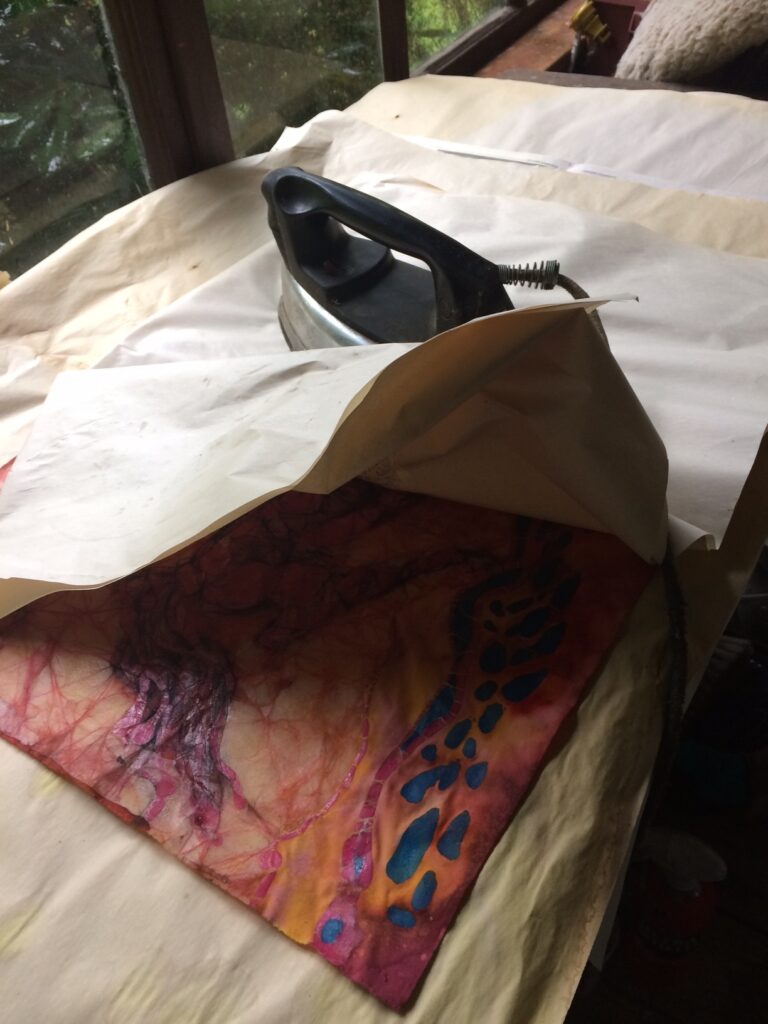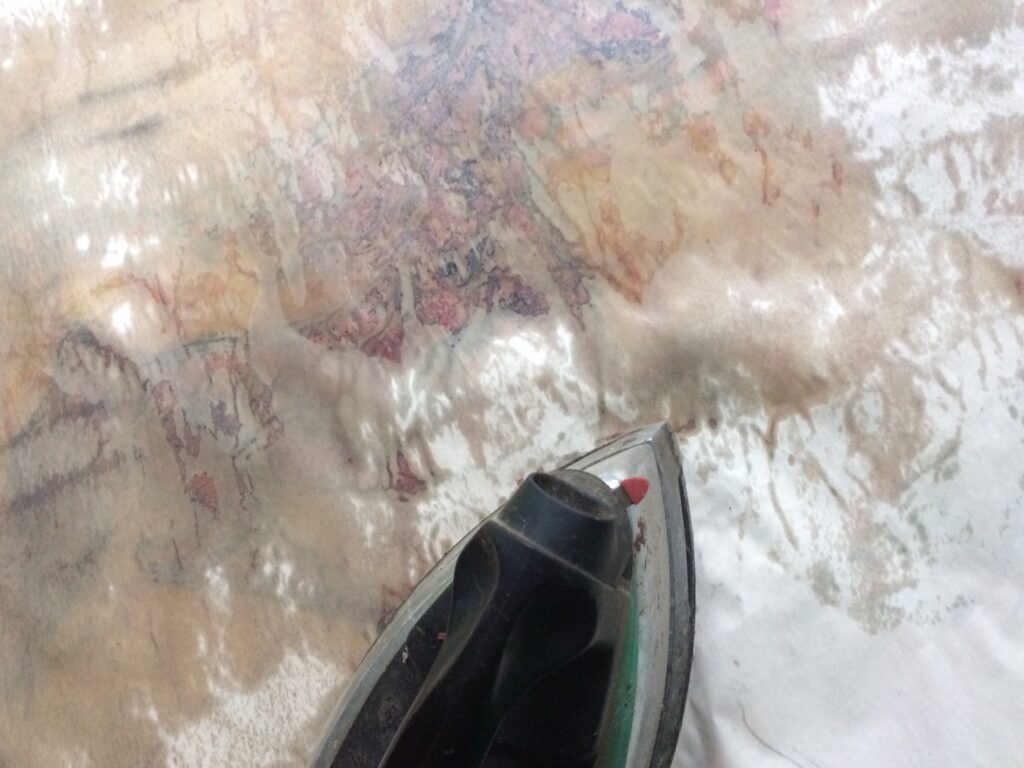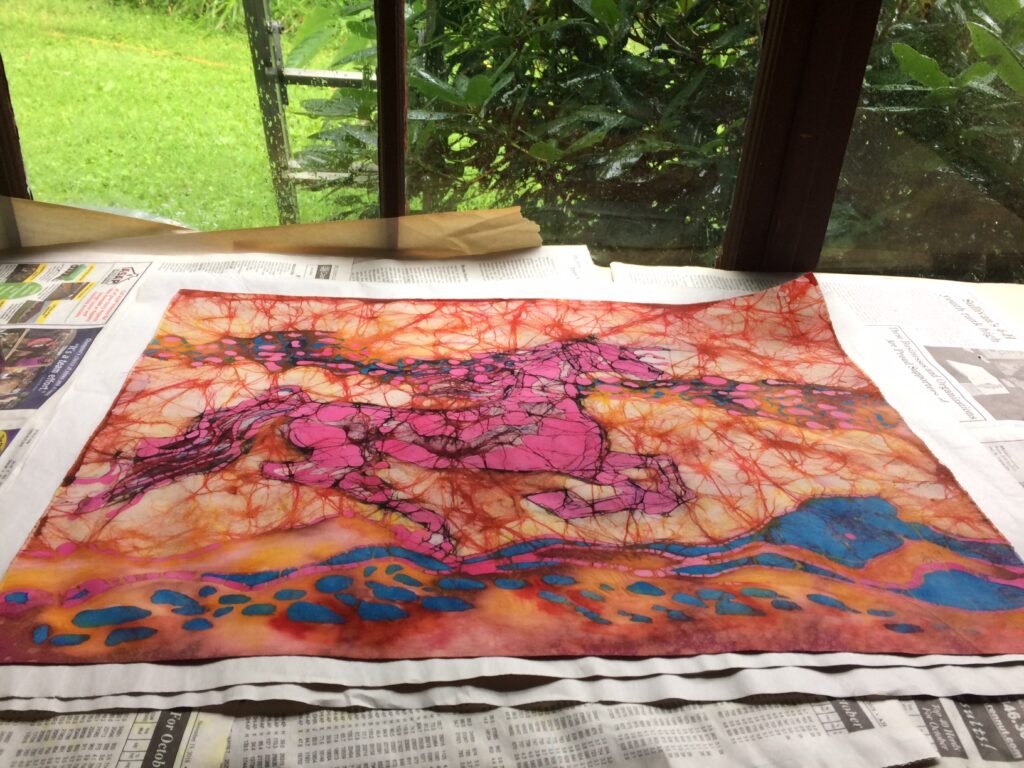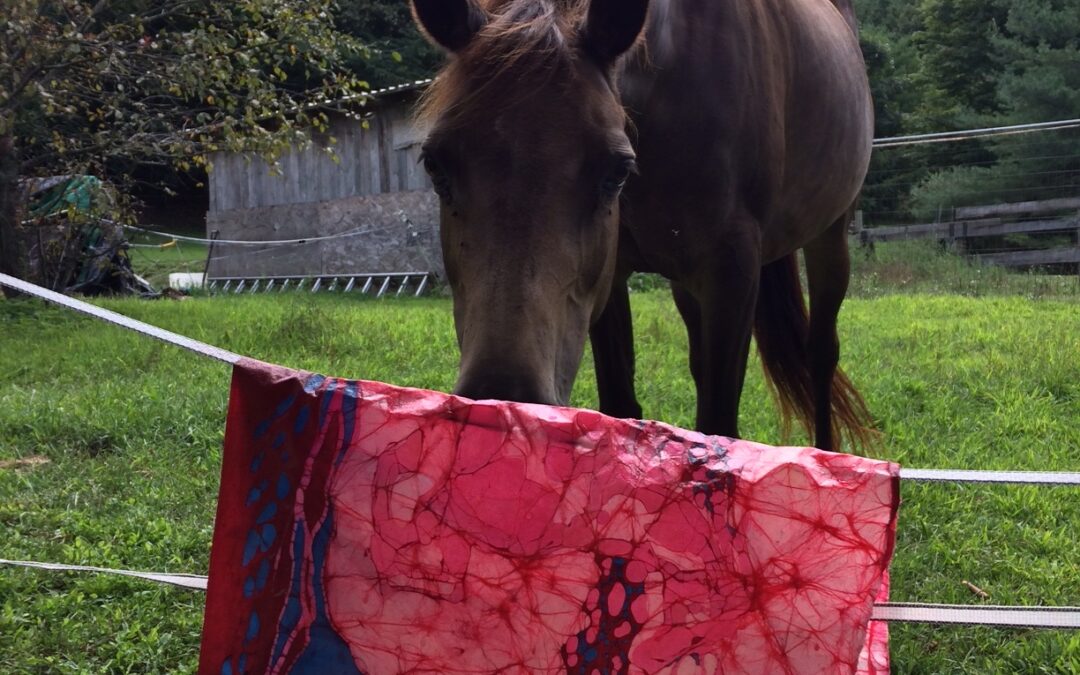The batik is finally finished, covered with wax, and now it’s time to remove it and reveal the bright colors underneath.

There are several ways to do this. Some artists, especially in Indonesia, boil the wax out of the fabric. This has the advantage of having the wax rise to the top, and when it cools, removing the wax and using it again. For my purposes, I have no good place to do this. Wax can boil over very easily, and with a gas stove it would be easy to burn the house down, so I don’t do this method. If there were an area with an outside fire pit, it would be well worth trying. I do a lot of large batik, which would make it even harder for me.
Another method is to use dry cleaning chemicals, fluid, I’m not sure the word, but I’m not anxious to try dealing with chemicals like that on my property. I have a feeling they would be bad to inhale, and also difficult to dispose of.
So my method is to iron the wax out by placing my batik between newsprint. The newsprint that is next to the batik has to be plain newsprint.

I can use old newspapers as a section to absorb beyond a layer of plain newsprint, but if it were next to the batik, the ink could transfer on to it. And that could be interesting if you want to have current events on your art, but I like to get away from that. Good for making political statements. In my art, I like to picture nature and a world almost without technology, even though I appreciate technology and appreciate working with it every day. But I like to see nature in what I call “all time.”

So I put down the plain layer of newsprint or a couple of layers of newsprint, then the batik, then more layers on top of the batik, and with my ancient hand iron, I start to go over the newsprint. When the paper is saturated with wax, I pull it apart and take it away and replace the bottom layer of newspaper, then place my batik, more clean newspaper on top, then iron again. The newspaper will likely need to be changed again. Some batik have a lot more wax than other batik, but a small batik can usually be ironed out in about fifteen minutes. Some of my larger pieces have taken over an hour to get the wax out of.

It’s not a great project for a hot day. I try to do it early in the morning. Sometimes in the evening, but out on my porch the heat lingers too late in the summertime. When all the wax has been removed, I have a big pile of newsprint which I crumple. I usually save it for the cool months and use it to start fires in the wintertime in our woo stove. It works great. As the batik appears with the wax out, the colors are brilliant. Before then, the wax adds a cloudy look to the artwork. But I also find the look very interesting.

After all these years, I am still excited by seeing my batik as they emerge from the wax.

On Monday, WMHT’s Matthew Rogowicz and Brian Flynn arrived to do an interview and take video of me doing my batik artwork. We had the interview out on the lawn next to my dye buckets on a beautiful summer morning.
I call it my outdoor studio. One reason I like to do my dyeing in the warm months is so I can have my buckets outside and spill and splash to my heart’s content without destroying my home. The air, the wind, was perfect. We had to stop talking when trucks drove by down on the highway, but Matt had lots of great questions for me, and Brian did a wonderful job of taking the videos and adjusting the cameras.
As I first sat down in the chair in front of the two lights and got my microphone, I had a few pangs of nervousness. My makeup crew had never shown up that morning and I was very lucky to have even brushed my hair, plus I had on my oldest jeans and a splattered shirt, which is what I need when I’m dyeing batik, as other clothing would soon look the same. But with good questions and great guys to work with, I relaxed and had a good time answering the questions.
It wasn’t long before everything, cameras, lights, and myself walked upstairs to see the beginning of the waxing process, the middle of the waxing process, and later times with the waxing process, with trips back downstairs and outside to go to the dye buckets, and a short session on bleaching colors out thrown in as well.
It was a good session, and I still hadn’t finished the final stage as the batik had to stay in the dye for an hour and I didn’t want to hold up Matt and Brian, so I sent down these pictures to them so they could see the result.
They also have many pictures of my original batik, and they will show the whole story on Wednesday night, August 28, at 7:30 on WMHT, which is Channel 11, and also 17, depending on your television provider. They will have something on their Facebook Page to go along with it, and I expect I will be able to provide a link so that people who are interested can hear the interview if they can’t get to see it on television.
I hope you will tune in, and remember that you can click here to shop.



Hey Girl.. How do you remove the wax if its on a dress? I take a turkey pot and boil it out with the turkey roaster i fill the water to the level of water line and then put in 1/2 cup of laundry detergent then i boil out the dresses in them for 2 hours its alot more work but they do come out clean and redo it again the next day for tee shirts and dresses, the way yuo did this with silk is good too.. silk does not take that much to do to boil out the wax as much as it is caused to do this by dresses.. more work.. talk soon
The turkey roaster is a good idea Linda, it can be covered and be safe.
I do very few dresses in batik now as my batik process gets so complicated, many with 12 or more wax and dye stages. I print many of the images onto fabric for clothing, this keeps the costs less. Some batik I work on for months to a year… Years back I would iron it and then bring it to the dry cleaner, times have changed, they won’t do that now and some of the new dry cleaning chemicals may damage the colors too.